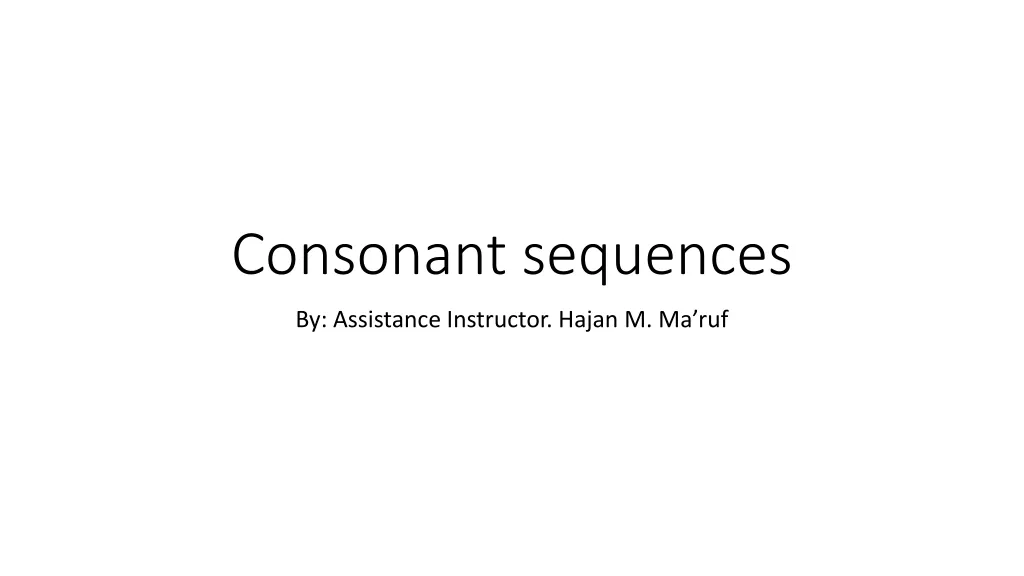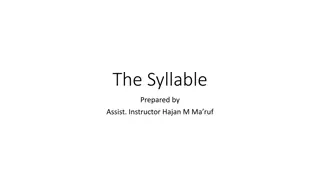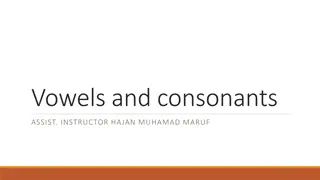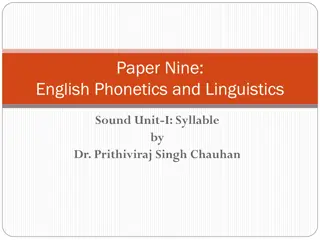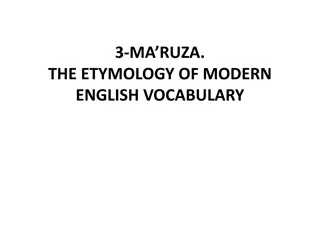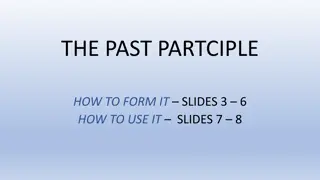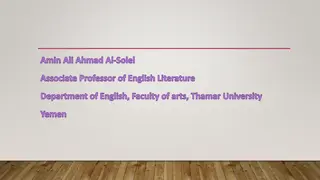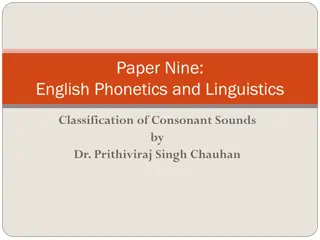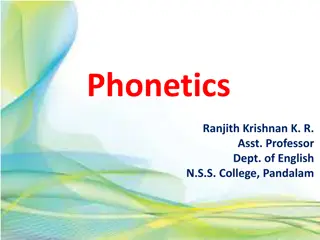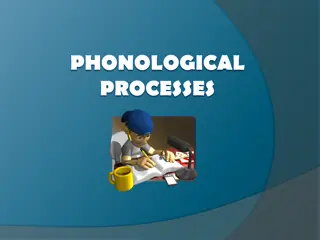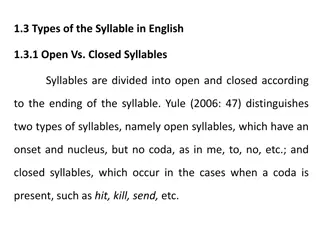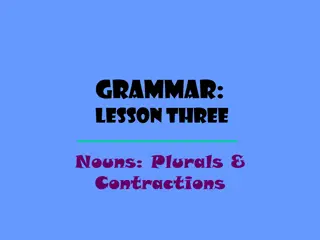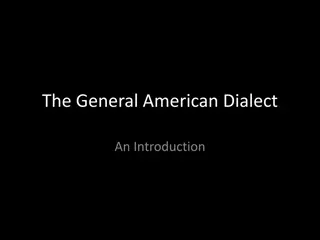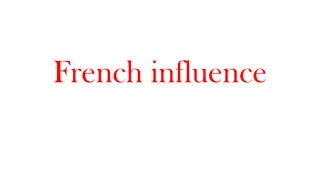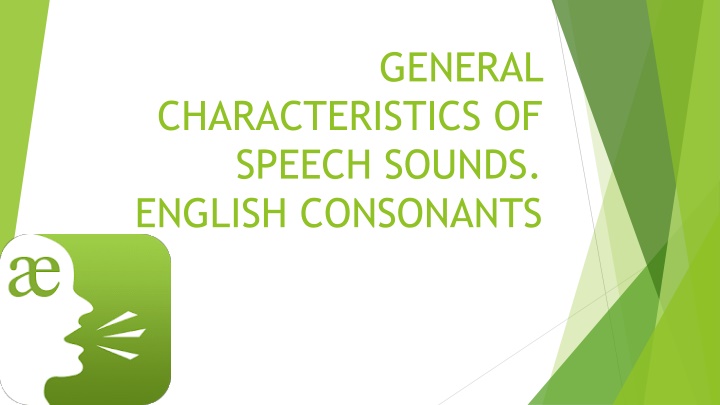
Characteristics of Speech Sounds and English Consonants
Explore the general characteristics of speech sounds, English consonants, and phonemes including aspects of articulatory, acoustic, auditory, and functional. Learn about the system of English phonemes, modifications in connected speech, and the role of phonemes in distinguishing meanings. Dive into the dynamic world of speech sounds and their linguistic significance.
Download Presentation

Please find below an Image/Link to download the presentation.
The content on the website is provided AS IS for your information and personal use only. It may not be sold, licensed, or shared on other websites without obtaining consent from the author. If you encounter any issues during the download, it is possible that the publisher has removed the file from their server.
You are allowed to download the files provided on this website for personal or commercial use, subject to the condition that they are used lawfully. All files are the property of their respective owners.
The content on the website is provided AS IS for your information and personal use only. It may not be sold, licensed, or shared on other websites without obtaining consent from the author.
E N D
Presentation Transcript
GENERAL CHARACTERISTICS OF SPEECH SOUNDS. ENGLISH CONSONANTS
PLAN 1. Aspects of speech sounds. 2. General characteristics of phonemes. 3. Notation. 4. Main trends in phoneme theory. 5. Methods of phonological analysis. 6. The system of English phonemes. Consonants. 7. The general characteristics of consonants. 8. Modifications of consonants in connected speech.
Speech sounds are produced by man's organs of speech. They travel in sound waves and are perceived by human's hearing mechanism as sounds of language functioning as units capable of differentiating meanings of the words. Speech sounds differ from each other in their physical/acoustic properties, in the way they are produced by the organs of speech and in their features which take part or do not take part in differentiating the meaning. We distinguish four aspects: - Articulatory - Acoustic - Auditory - Functional None of them can be separated in the actual process of communication but they can be singled out for linguistic analysis.
The articulatory/sound production aspect Every speech sound is a complex of definite coordinated and differentiated movements and positions of speech organs. The movements and positions necessary for the production of a speech sound constitute its articulation. The acoustic aspect Every speech sound is a complex of acoustic effects and has its Physical properties - it is a physical phenomenon, a kind of moving matter and energy. The Physical properties of speech sounds consist of: 1) Frequency 2) Spectrum 3) Intensity 4) Duration The auditory/sound-perception aspect Involves the mechanism of hearing. It is a kind of psychological mechanism which reacts to the physical properties of speech sounds, selecting from a great amount of information only the one which is linguistically relevant The functional/linguistic/social aspect Is called so because of the role the sounds of language play in its functioning as medium of human communication.
General characteristics of phonemes When we talk about the sounds of a language, the term "sound" can be interpreted in two rather different ways. A linguist uses two separate terms: "phoneme" is used to mean "sound" in its contrastive sense "allophone" is used for sounds which are variants of a phoneme. They usually occur in different positions in the word, cannot contrast with each other and cannot be used to make meaningful distinctions. tie die seat seed Phoneme is a minimal abstract unit realized in speech sounds opposable to other phonemes of the same language to distinguish the meaning of morphemes and words.
The opposition of phonemes in the same phonetic environment differentiates the meaning of morphemes and words Phoneme is a functional unit. Function is usually understood to mean discriminatory function (the role of the various components of the phonetic system language in distinguishing morpheme from another, one word from another or also one utterance from another). said says sleeper sleepy bath path light like of the one Sometimes the opposition of phonemes serves to distinguish the meaning of the whole phrases Secondly, the phoneme is material, real and objective. That means that it is realized in speech of all English- speaking people in the form of speech sounds, its allophones. He was heard badly He was hurt badly. Thus we may say that the phoneme can fulfil the distinctive function. The sets of speech sounds, that is the allophones belonging phoneme are not identical in their articulatory content though there remains some phonetic similarity between them. to the same
Allophones of the same phoneme, no matter how different their articulation may be, function as the same linguistic unit. At the same time native speakers realize that allophones of each phoneme possess a set of distinctive features, that makes this phoneme functionally different phonemes of the language. This functionally irrelevant feature is called invariant of the phoneme. Neither of the articulatory features that form the invariant of the phoneme can be changed without effect on the articulatory features that form the invariant of the phoneme are called distinctive or relevant. from all other meaning. The To extract a relevant feature of the phoneme we have to oppose it to some other phoneme in the same phonetic context. If the opposed sounds differ in one articulatory feature and this difference brings about changes in the meaning of the words the contrasting features are called relevant. The articulatory features which do not served to distinguish meaning are called non-distinctive, irrelevant or redundant.
If an allophone of some phoneme is replaced by an allophone of a different phoneme the mistake is called phonological, because the meaning changes. If an allophone of the phoneme is replaced by another allophone of the same phoneme the mistake is called phonetic as far as the meaning stays the same. beat bit
Notation. The symbolization of sounds naturally differs according to whether the aim is to indicate the phoneme or to reflect the modifications of its allophones as well. Transcription is a set of symbols representing speech sounds. The International Phonetic Association has given accepted values to an inventory of symbols, mainly alphabetic but with additions. The first type of transcription is called the broad or phonemic transcription, which provides special symbols for all the phonemes of a language. The second type, the narrow or allophonic transcription, suggests special symbols including some information about articulatory activity of particular allophonic features. The first type was introduced by D. Jones. The broad transcription is mainly used for practical purposes like studying a foreign language while the narrow is used for the researches.
Use of phoneme fall into four classes Main trends in phoneme theory Psychological view regards the phoneme as an ideal mental image or target at which the speaker aims. Functional view regards the phoneme as the minimal sound unit by which meanings may be differentiated without much regard to the actual pronounced speech sounds. Physical view regards the phoneme as a family of related sounds satisfying certain conditions. Abstract view of phoneme regards phonemes as independent of acoustic and psychological properties associated with them.
Methods of phonological analysis The aim of the phonological analysis is, firstly, to determine which differences of sounds are phonemic and which are non-phonemic and, secondly, to find the inventory of the phonemes of this or that language. For an unknown language the procedure of identifying the phonemes of a language as the smallest language units has several stages. The first step is to determine the minimum recurrent segments and to record them graphically by means of allophonic transcription. The next step is the arranging of sounds into functionally similar groups. According to the distributing method all the sounds pronounced by native speaker are grouped into phonemes according to two laws of phoneme and allophonic distribution. The second law: allophones of the same phoneme never occur in the same phonetic context. The first law: allophones of different phonemes occur in the same phonetic context. If more or less similar speech sounds occur in different positions and never occur in the same phonetic context they are allophones of one and the same phoneme. In this case their distribution is complementary. If more or less different sounds occur in the same phonetic context they should be allophones of different phonemes. In this case their distribution is contrastive.
The system of English phonemes. Consonants. A speech sound is produced as a result of definite, coordinated movements and positions of speech organs, so the articulation of the sound consist of articulatory features. Grouping speech sounds according to their major articulatory features is called articulatory classification. According to the specific character of the work of the speech organs, sounds in practically all languages are divided into vowels and consonants.
There are some differences between vowels and consonants The most substantial articulatory difference between vowels and consonants is that in the articulation of vowels the air passes freely through the mouth cavity, while in making consonants an obstruction is formed in the mouth cavity and the airflow exhaled from the lungs meets a narrowing or a complete obstruction formed by the speech organs. Consonants articulations are relatively easy to feel, and as a result are most conveniently described in terms of place and manner of articulation. Vowels have no place of obstruction, the whole of speech apparatus takes place in their formation, while the articulation of consonants can be localized, an obstruction or narrowing for each consonant is made in a definite place of the speech apparatus. The particular quality of Vs depends on the volume and shape of the mouth resonator, as well as on the shape and the size of the resonator opening. The mouth resonator is changed by the movements of the tongue and the lips. The particular quality of Cs depends on the kind of noise that results when the tongue or the lips obstruct the air passage. The kind of noise produced depends in its turn on the type of obstruction, on the shape and the type of the narrowing. The vocal cords also determine the quality of consonants. From the acoustic point of view, vowels are called the sounds of voice, they have high acoustic energy, consonants are the sounds of noise which have low acoustic energy Functional differences between vowels and consonants are defined by their role in syllable formation: vowels are syllable forming elements, consonants are units which function at the margins of syllables, either singly or in clusters.
Consonants are divided into The general characteristics of consonants occlusive constructive sonorants noise consonants sonorants noise consonants affricates medical lateral plosives glottal labial lingual bilabial labio-dental forelingual mediolingual backlingual
Language in everyday use is not conducted in terms of isolated, separate units; it is performed in connected sequences of larger units, in words, phrases and longer utterances. Consonants are modified according to the place of articulation. Assimilation takes place when a sound changes its character in order to become more like a neighbouring sound. Modifications of consonants in connected speech The manner of articulation is also changed as a result of assimilation, which includes: - loss of plosion. In the sequence of two plosive consonants the former loses its plosion. - nasal plosion. In the sequence of a plosive followed by a nasal sonorant the manner of articulation of the plosive sound and the work of the soft palate are involved, which results in the nasal character of plosion release. - lateral plosion. In the sequence of a plosive followed by the lateral sonorant the noise production of the plosive stop is changed into that of the lateral stop.


